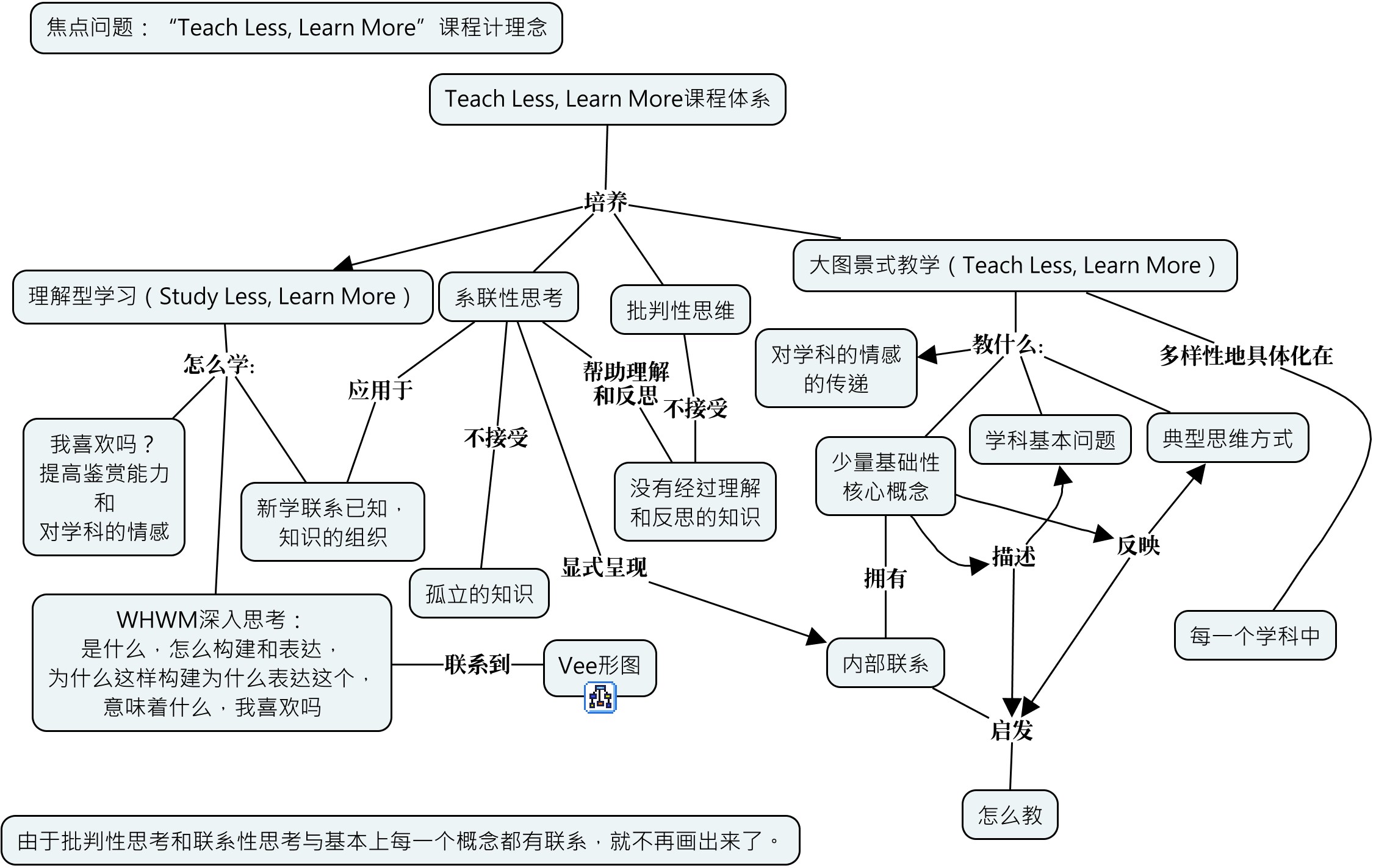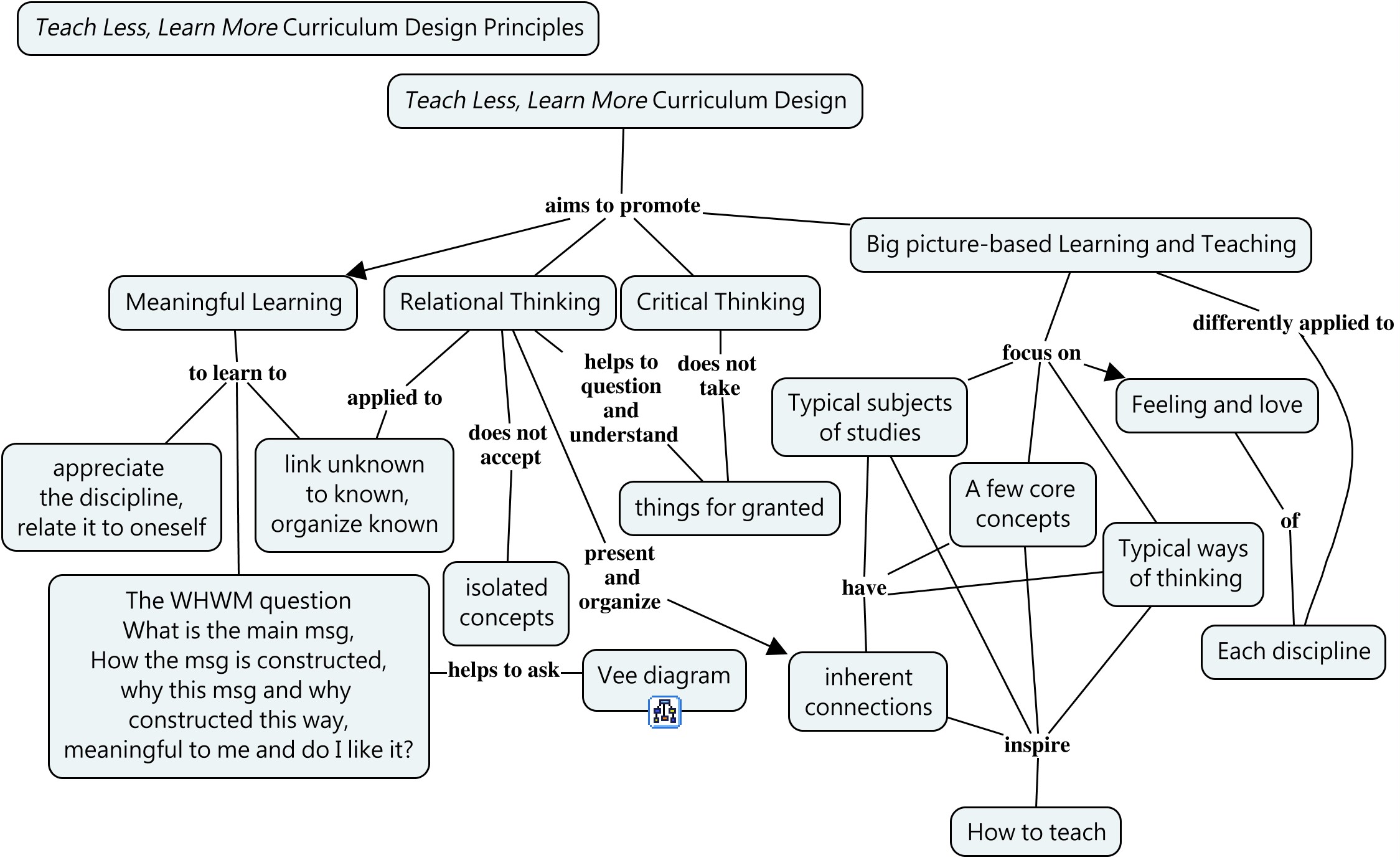学会学习和思考的设计原则

本课程的最终目标是帮助学生学会如何学习,学会如何思考,尤其是批判性的系联性的独立的思考。
我们相信“做中学”,于是当人们要学会如何学习的时候,必须真的学点东西,学点不是那么简单的东西。因此,在这门课程中我们企图传授两样东西:(1)关于理解型学习的思想和技术,(2)学习专业领域的知识(例如物理学、化学、生命科学、地球科学、语言学、语言、经济学、社会研究、教学学、教育研究)。
大量的描述性的知识对学生来说常常是影响学生创造性和批判性思考的障碍,尽管同时,知识也是创造和批判的基础,并提供了创造性思考的方向。那么,面对着对矛盾,我们怎么办?我们相信,知识一旦被深刻地和真正地理解了,通常表现为看到更多的联系,就会更多地成为创造的助推剂而不完全是障碍。
这门课程的另外一个设计理念是我们相信学习的目的是为了获得理解,获得对一门学科的大图景的理解以及对这们学科的热爱,而不是为了获得更多的或者完整的知识。因此,本课程的具体学科模块中所选择用来学习讨论的内容通常是这个学科的基本思想,基本问题、典型思考方式和典型分析方法。我们会尽量避免传授给你太多的描述性知识,而是主要关注最核心的有助于学生理解本学科大图景的知识。
我们同时还相信“教的少,学得多”的教学理念。因此,我们把大部分学习任务都留给了学生,老师通常是教练、导师的角色,来引导和帮助学生。
我们还相信,学生在面对挑战的时候成长的最快。因此,在所有的专业领域的模块里面,我们会有课后作业和阅读材料。它们可能来自于书籍、论文,而这些材料需要学生自己来寻找和阅读。有的时候,这些作业可能会作为课程项目,这样的问题可能本身就一个开放的问题,或者是一个非平庸的研究课题。我们希望学生能够理解相应的领域的科学家的思考方式。有的时候这些作业需要你去探索几种不同的解法。这样的探索有助于提高创造性。
部分课程包含问题解决模块。在那里学生的求解问题的能力会得到提高。这个时候学生可能独立完成也可能通过学习小组来完成。我们鼓励问题的原创的或者是创造性的答案。这样的答案在本课程中会被高度评价。解决问题的能力也是一个适宜用做中学的方式来提高的重要技能。
这门课程从结构上由多个18学时的模块构成。其中一个模块是关于理念和技巧的训练,在那里学生学习到理解型学习的思想以及概念地图制作的技术。在这里,所用的例子会比较贴近学生的日常生活,但是也是需要学生投入比较深入的思考的非平庸的问题。在课程实践中,我们也会逐渐积累这样的例子,以供更多的人来做类似的培训模块的时候使用。
本课程也会包含一定数量的基于领域知识的模块,例如关于物理学、化学、生命科学、地球科学、语言学、语言、经济学和社会研究的模块。理想情况下,这些模块的主讲人都是相应领域的专家,热爱这个领域,能够把核心内容从这个学科里面抽取出来,并且善于和学生们分享这些核心内容、核心内容的结构,以及对这们学科的热爱。
实际上,我们的理念是,任何课程都应该重新梳理一下,按照“教的少,学得多”的原则,仅保留能够呈现学科大图景的核心知识结构,而不仅仅是我们这一门课程。这是一个任重道远的任务和目标。
教给学生核心内容,帮助学生理解和思考,深入地、批判性地、创造性地、独立地思考,把其它学习任务都交给学生。
最后这门课程课定不是一门容易的课程。学生们需要完成技能训练模块和至少一个专业领域模块。期间,学生们需要完成大量的阅读、作业、课堂和课后的概念地图制作、与老师和同学之间的大量的课堂讨论,以及课程项目,还有课程项目口头报告。基于之前的课程的经验,我们估计,在这个四周的课程内,学生们大约需要花60小时的课内时间和40小时的课后时间。
在这们课程之后,我们希望,学生们可以获得:一些理解型学习的思想和技能、一个独立地创造性地批判性地思考的习惯、一个感兴趣的学科的大图景、一份对这个学科的热爱,以及一些长着类似的脑袋的朋友们。
我们鼓励你来选择这门课程,但是,小心,请多考虑一下。那些冲着学分而不是理念和技能来的学生,请不要选择这个课程。否则,在这个课程里面,你会非常难受。
对学生的要求:知识上,各个模块有具体要求,一般来说,要求各个专业的本科一年级以上水平。时间上,需要能够有上面提到的100小时的时间。最重要的是,在态度上,希望超越记忆型学习。
参考文献:
1. Whitehead(怀特海)《教育的目的》
2.Novak(诺瓦克)《学习、创造与使用知识——概念图促进企业和学校的学习变革》
3. 吴金闪《概念地图教学和学习方法》
Designing principles of Learning How to Learn and Think

The ultimate objectives of this course are to help students learn how to learn and learn how to think, critically, independently and in terms of relations.
We believe in “Learning by Doing” and that when learning how to learn , one has to learn something, something nontrivial. Therefore, we propose to offer in this course two elements: (1) ideas and skills of meaningful learning and (2) learning domain-specific subject matters (such as physics, chemistry, life science, earth science, environmental science, linguistics, language, economics and social studies, pedagogy, education research).
Excessive descriptive knowledge of scientific concepts may become an obstacle that constrains students’ creative and critical thinking; however, meanwhile knowledge does serve as a foundation and sense of directions for creativity. So how to deal with these conflicting roles of knowledge? We believe that knowledge when understood deeply and truly, which often means seeing more connections, is less an obstacle and more a booster for creativity.
Another principle behind this course design is that we believe the goal of learning is not to gain as much knowledge as possible, but to gain an understanding of the underlying structure of a discipline, especially an understanding of the big picture and a deep love of the discipline. So the subject modules are selected topics in the field to present the basic ideas, basic questions, typical ways of thinking and basic approaches of analysis of the field. We intend to avoid excessive descriptive knowledge, but to focus instead on the conceptual core that helps students to grasp the big picture.
We also believe in the principle of “Teach Less, Learn More”. Thus we leave most of the learning to students, while instructors play the role of mentors or coaches, who guide and help students.
We also believe that students grow faster when facing challenges. Thus, in all subject matter modules there will be reading materials and homework questions coming from books and research papers which students will have to discover and read on their own. Some of those questions will be in the form of course projects, which may come from open questions in the field and may be highly non-trivial. We want students to understand how experts of the fields think and to become acquainted with their habits of mind. Some homework questions are designed in a way such that various solutions can be found. We encourage students to come up with innovative solutions. We believe that tackling homework questions creatively helps to foster creativity in real world problem solving.
Part of the course will have problem-solving sessions to improve students’ problem solving skills. For this reason, students will work in cooperative groups and alone, on the representation, analysis of the problem and on reducing complexity. Original and creative solutions will be encouraged. Creative solutions will have high value in the course. The ability to solve problems is an important skill learned by doing.
The overall course structure will be composed of several 18-hour modules: One module will focus on ideas and skills training, where the idea of meaningful learning and the technique of concept mapping will be introduced to students. Here examples should be close to students’ everyday life but still non-trivial, i.e. requiring some deep thinking to understand the topics. We should gradually collect those examples to form a toolbox for others to run this kind of training sessions to general audiences.
A number of additional modules will focus on domain-specific subject matter, such as physics, chemistry, life science, earth science, linguistics, language, economics and social studies. Ideally, instructors of those modules should be experts in the corresponding disciplines, who love the disciplines, know how to extract the core knowledge structure out of the disciplines and also are capable of sharing their feelings and the structures to the students.
In fact, we believe that all courses should be reconstructed to keep only the core parts of the knowledge structures sufficient to present the big picture of the disciplines. This principle of “Teach Less, Learn More” should be implemented not only in this course of Learning How to Learn and Think, but also to many other subject matter courses.
Teach students only the core parts, help the students understand them well and think independently, deeply, creatively and critically, and leave all other learnings to the students.
Finally, this is not an easy course. Student are expected to take the training module and at least one domain-specific module, to do a lot of reading, assignments, concept mapping activity in and after classes, and in-class discussion with instructors and among peer students. Students are also required to do course projects and present the project reports in classes. We estimate according to previous classes that on average students spend 60 in-class hours and 30 after-classes hours in the four weeks.
After this course, hopefully, students will acquire some ideas and skills on meaningful learning, a habit of thinking creatively, critically and independently, a big picture of the field of interest, deep love to the field of interest and some friends with alike minds.
We encourage you to choose this course, but with caution. Those, who are aiming for credits rather than the ideas and skills, please do not choose this course. Otherwise, you will suffer the whole course miserably.
Prerequisite: Knowledge wise, every module has its own requirement, but generally, it should be sufficient if students have the knowledge corresponding to the first year of university education of the discipline. Time wise, it is expected that students will be able to devote the 90 hours mentioned above. Attitude wise, which is most important, it is necessary that students have already the eager to go beyond rote learning.
References:
1. Alfred North Whitehead, Aims of Education
2.Joseph D. Novak, Learning, Creating, and Using Knowledge: Concept Maps as Facilitative Tools in Schools and Corporations
3. Jinshan Wu, Teach Less, Learn More
附件:
2017年秋季《学会学习和思考》开课信息(2017 Fall course format, time, places)
“教的更少,学得更多”课程的设计要求(Structures of a TLLM course design)
《学会学习和思考之理解型学习理念和技能》设计(Course design of LHLT ideas and skills of meaningful learning)
《学会学习和思考之物理学》设计(Course design of LHLT physics module)
《学会学习和思考之教育学》设计(Course design of LHLT education module)
《学会学习和思考之科学和科学教育》设计(Course design of LHLT science and science education research module)
《学会学习和思考之教育和教育研究》设计(Course design of LHLT education and education research module)
《学会学习和思考之地球科学》设计(Course design of LHLT geology module)
《学会学习和思考之环境科学》设计(Course design of LHLT environmental science module)
《学会学习和思考之化学》设计(Course design of LHLT chemistry module)
《学会学习和思考之生命科学》设计(Course design of LHLT life science module)
“Teach Less, Learn More”课程设计举例:量子力学(Course design of Quantum Mechanics)
“Teach Less, Learn More”课程设计举例:系统科学导引(Course design of Invitation to System Science)